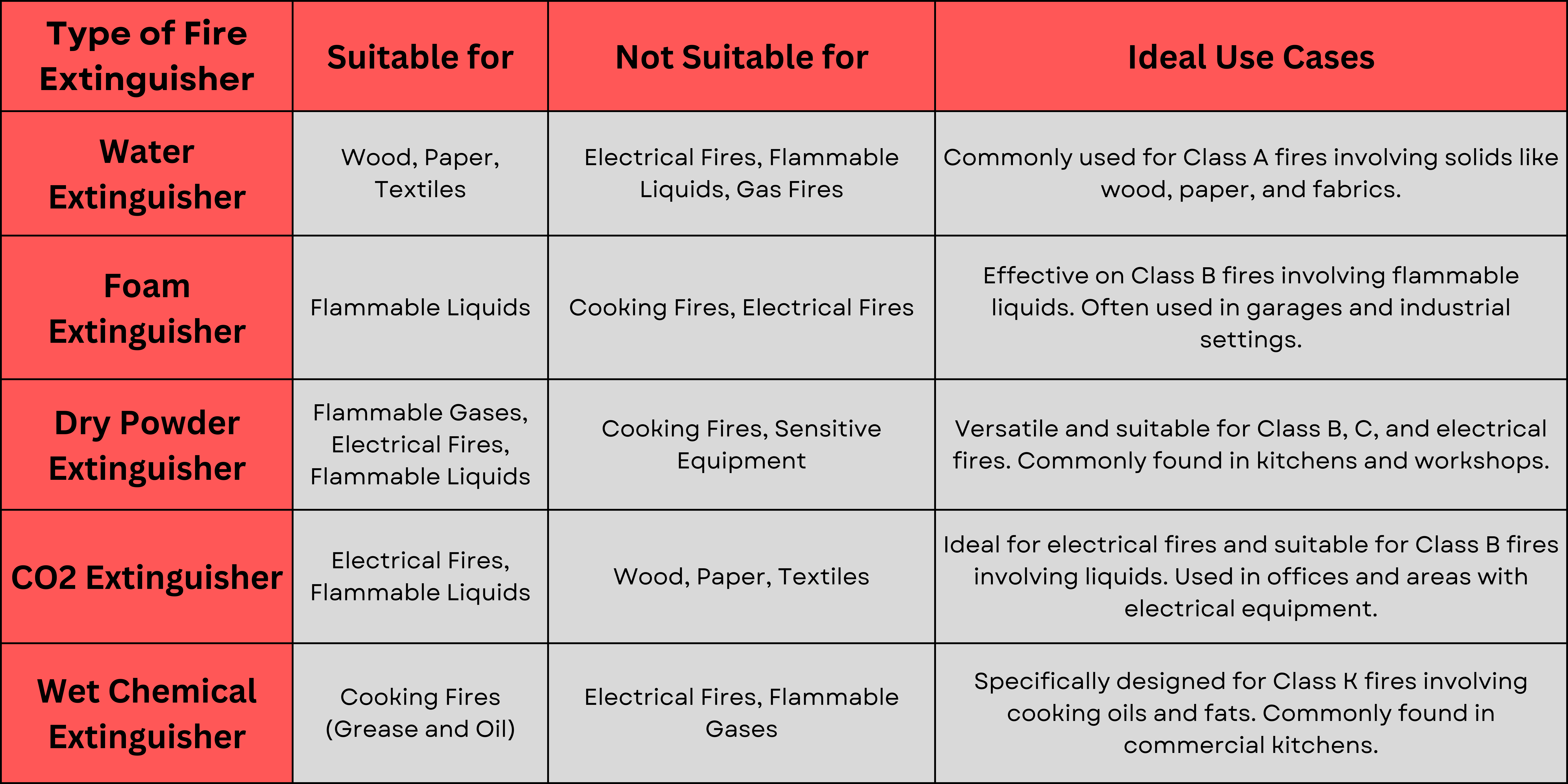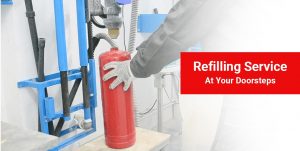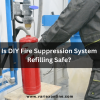![]()
Fire Immuniser
+91-7829629111
Email: info@variex.in
Varistor Technologies Pvt. Ltd.
Block-1, First Floor, Ardente Office One, Hoodi Circle, ITPL Main Road, Bengaluru, Karnataka 560048, IN
Which Fire Extinguishers Are Refillable, And Which Ones Are Not?
When it comes to fire safety, having the right fire extinguisher can be a lifesaver. But have you ever wondered if you can refill them or if you need a new one? Enter our guide: "Which Fire Extinguishers Are Refillable, And Which Ones Are Not?" In simple terms, we're here to break down the nitty-gritty of fire extinguishers. We'll help you understand which ones you can top up and which ones you'll have to replace, ensuring you're not just safe but also savvy in keeping your firefighting gear up to the mark. Let's dive in!
In the dynamic landscape of fire safety, the role of a reliable fire extinguisher is paramount. Addressing the query of refillability becomes pivotal. "Which Fire Extinguishers Are Refillable, And Which Ones Are Not?" encapsulates the essence of this exploration, delving into the intricacies of fire safety. This journey unfolds the diverse landscape of extinguisher functionality, emphasizing the need for informed decisions, routine maintenance, and a comprehensive understanding of refillable and non-refillable variants.
Types of fire extinguishers
Fire safety is a critical aspect of personal and public well-being, and at the heart of this safety protocol are fire extinguishers. These life-saving devices come in various types, each designed to combat specific types of fires. In this exploration of "Types of Fire Extinguishers," we'll unravel the basics, helping you understand the different classifications and the unique roles each extinguisher plays in keeping us safe. From tackling everyday materials like wood and paper to addressing electrical and flammable liquid fires, let's delve into the essential knowledge that empowers us to respond effectively in the face of a fire emergency.
Refillable Fire Extinguishers
Refillable fire extinguishers offer long-term benefits, allowing users to replenish them after use. Here are common types of refillable fire extinguishers and the reasons why they are suitable for refilling:
1. Dry Chemical Extinguishers
- Suitable Fires: Class A, B, and C fires.
- Description: Uses dry chemical agents to suppress flames.
- Refillability: Dry chemical extinguishers are often refillable due to their design, allowing users to recharge them with the appropriate dry chemical powder after use.
2. Water and Foam Extinguishers
- Suitable Fires: Class A fires.
- Description: Cools and smothers fires, preventing reignition.
- Refillability: Water and foam extinguishers can typically be refilled, as they are designed to be replenished with water or foam concentrate after deployment.
3. CO2 (Carbon Dioxide) Extinguishers
- Suitable Fires: Class B and C fires.
- Description: Displaces oxygen to extinguish fires.
- Refillability: CO2 extinguishers are often refillable, allowing users to recharge them with carbon dioxide after use.
Non-refillable Fire Extinguishers
Non-refillable fire extinguishers are designed for one-time use, and they are typically disposed of after deployment. Here are common types of non-refillable fire extinguishers and reasons why they are not refillable:
1. Disposable Dry Chemical Extinguishers
- Suitable Fires: Class A, B, and C fires.
- Description: Uses dry chemical agents.
- Non-Refillable: The disposable nature is due to the difficulty of safely refilling these extinguishers with the precise amount and type of dry chemical needed.
2. Disposable Halon Extinguishers
- Suitable Fires: Class A, B, and C fires.
- Description: Uses halon gas as the extinguishing agent.
- Non-Refillable: Halon is an ozone-depleting substance, and its production has been phased out. As a result, these extinguishers are not refillable to prevent the release of halon into the environment.
3. Disposable Water Mist Extinguishers
- Suitable Fires: Class A, B, C, and K fires.
- Description: Uses ultra-fine water mist to suppress fires.
Non-Refillable: The complex technology involved in creating the fine water mist makes these extinguishers challenging and costly to refill safely.
Refillable vs. Non-refillable Fire Extinguishers: Navigating the Choices
Understanding Refillable Fire Extinguishers
Fire safety is a dynamic field, and choosing the right fire extinguisher involves understanding whether it's refillable or not. Refillable fire extinguishers offer distinct advantages in terms of cost, sustainability, and long-term usability.
Benefits of Refillable Extinguishers
Refillable fire extinguishers, unlike their disposable counterparts, can be refilled and reused after deployment. This feature provides several benefits:
- Cost-Effectiveness: Refillable extinguishers can be more cost-effective in the long run. Instead of purchasing a new extinguisher after each use, you can simply refill the existing one, saving both money and resources.
- Sustainability: With a focus on environmental responsibility, refillable extinguishers contribute to sustainability by reducing the waste generated from disposable units.
- Long-Term Use: Refillable extinguishers are built for durability, allowing for extended use and reliability over time. This makes them a practical choice for continuous protection.
Common Refillable Extinguisher Types
Refillable fire extinguishers come in various types, each tailored to combat specific types of fires. Common types include:
- Dry Chemical Extinguishers: Effective against Class A, B, and C fires, these extinguishers use dry chemical agents to suppress flames.
- Water and Foam Extinguishers: Ideal for Class A fires, these extinguishers cool and smother the fire, preventing reignition.
Non-refillable Fire Extinguishers
While refillable extinguishers have their advantages, non-refillable options are also prevalent, offering simplicity and convenience.
Characteristics of Non-refillable Extinguishers
Non-refillable fire extinguishers, often labeled as disposable, are designed for one-time use. Once discharged, they need to be replaced. Key characteristics include:
- Convenience: Non-refillable extinguishers are straightforward and convenient. After use, you discard them and replace them with a new unit.
- Limited Lifespan: These extinguishers have a finite lifespan, typically determined by their contents and design. Regular inspections are essential to ensure they remain viable.
Considerations for Non-refillable Options
Choosing a non-refillable extinguisher requires careful consideration:
- Single-Use Scenarios: Non-refillable extinguishers are suitable for scenarios where a single-use device is sufficient and replacement is practical.
- Maintenance Awareness: Regular inspections are crucial for non-refillable extinguishers. Ensuring they are in good condition is imperative for reliable performance.
Initial Costs of Refillable vs. Non-refillable Extinguishers
When delving into the realm of fire safety, a pivotal question arises: Which fire extinguishers are refillable, and which ones are not? Unraveling this inquiry leads us to a nuanced exploration of the initial costs associated with both refillable and non-refillable extinguishers.
Refillable Extinguishers: An Investment in Longevity
Refillable fire extinguishers, although carrying a higher upfront cost, present a strategic investment. These extinguishers are designed to be replenished after use, offering sustained protection without the need for frequent replacements. The initial investment involves a comprehensive evaluation of extinguisher type, capacity, and construction materials, considering factors that contribute to both effectiveness and long-term cost efficiency.
Key Considerations:
- Investment for Reusability: While the initial cost may be higher, refillable extinguishers offer an opportunity for multiple uses, reducing the need for frequent replacements.
- Variety in Pricing: Different extinguisher types and brands may vary in initial costs, providing flexibility to align with budget constraints.
- Reduced Environmental Impact: The refillable nature of these extinguishers contributes to sustainability by minimizing waste generation.
Non-refillable Extinguishers: An Affordable Yet Limited Choice
Non-refillable extinguishers, in contrast, typically come with a lower initial cost. However, their affordability comes with a caveat – they are designed for single-use scenarios, requiring replacement after each deployment. The apparent savings in the initial purchase may be offset by the need for more frequent acquisitions.
Key Considerations:
- Affordability: Non-refillable extinguishers are often more budget-friendly initially, making them an attractive option for those with financial constraints.
- Simplicity in Cost Structure: Replacement costs are straightforward, requiring the purchase of a new extinguisher after each use.
- Limited Long-Term Use: The cost advantage may diminish over time, especially in settings where frequent replacements are necessary.
Long-term Cost Analysis
As we delve deeper into the cost considerations, the focus shifts to the long-term analysis of both refillable and non-refillable extinguishers. The overarching question persists: Which fire extinguishers are refillable, and which ones are not? This inquiry shapes our understanding of the sustained financial implications associated with fire safety measures.
Refillable Extinguishers: A Sustainable Financial Approach
Despite the higher initial investment, refillable extinguishers exhibit long-term cost-effectiveness. The ability to refill these extinguishers after use ensures sustained protection without the need for continuous purchases.
Key Considerations:
- Cost Savings Over Time: Refilling incurs lower costs than purchasing new extinguishers, resulting in substantial savings over the extinguisher's lifespan.
- Sustainability Benefits: The environmentally friendly approach of refillable extinguishers aligns with sustainable practices, appealing to eco-conscious consumers.
- Extended Service Life: Well-maintained refillable extinguishers can provide reliable service for an extended period, reducing the frequency of replacements.
Non-refillable Extinguishers: A Question of Cumulative Expenses
Non-refillable extinguishers, while initially more affordable, may lead to higher long-term costs, especially in settings where frequent replacements are necessary. Each use necessitates a new purchase, contributing to cumulative expenses over time.
Key Considerations:
- Replacement Costs: Frequent replacements can result in higher long-term expenses.
- Environmental Impact: The disposal of non-refillable extinguishers contributes to waste generation, potentially conflicting with sustainability goals.
- Single-Use Limitation: The limited usability may prompt more frequent purchases, impacting overall cost-effectiveness.
In conclusion, the exploration of fire extinguisher refillability is crucial for establishing robust fire safety measures. Throughout this comprehensive discussion on various fire extinguisher types, the focal point has been the distinction between refillable and non-refillable options.
Understanding "Which Fire Extinguishers Are Refillable, And Which Ones Are Not?" transcends mere convenience; it stands as a pivotal factor in the safety and functionality of these life-saving devices. Refillable extinguishers emerge as sustainable and cost-effective solutions, boasting multiple uses and prolonged service life. This sustainability aligns seamlessly with contemporary environmental consciousness, making them the preferred choice for those committed to waste reduction and eco-friendly practices.
Frequently Asked Questions
1. What is the key difference between refillable and non-refillable fire extinguishers?
Refillable fire extinguishers can be recharged after use, extending their service life, while non-refillable extinguishers are designed for one-time use and are usually replaced after discharge.
2. Are all types of fire extinguishers refillable?
Not all types are refillable. While some extinguisher types, such as dry chemical and CO2, are commonly refillable, others like disposable aerosol models are designed for single-use only.
3. Why choose a refillable fire extinguisher over a non-refillable one?
Refillable extinguishers offer long-term cost savings and contribute to environmental sustainability by reducing waste. They can be recharged after use, providing extended protection.
4. Can I refill a fire extinguisher on my own?
It depends on the type of extinguisher. Some can be refilled by professionals, while others require specialized equipment and knowledge. DIY refill attempts may compromise safety.
5. How often should fire extinguishers be refilled?
The frequency of refilling depends on the type of extinguisher, usage, and manufacturer recommendations. Regular inspections and professional assessments can determine the need for refilling.
Final Say
We at VariEx.in or Variexonline.com have mastered the art of designing, installing, inspecting, and fixing automatic sprinkler systems with the help of our in-house team, which is capable of delivering the fire sprinkler services you need, whether large or small and at affordable cost.
To schedule a fire sprinkler installation, or you think our services could benefit your commercial property, contact us online or give us a call at, 7829629111










